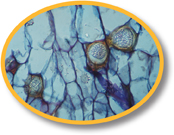Zygomycetes
The hyphae of zygomycetes generally lack cross walls between cells. Zygomycetes get their name from the sexual phase of their reproductive cycle, which involves a structure called a zygosporangium that forms between the hyphae of two different mating types. One group within the zygomycetes, the Glomales, form symbiotic mycorrhizae (my koh RY zee) with plant roots.

The fruiting body of the common black bread mold, Rhizopus stolonifer (SEM 450X)

This micrograph shows mycorrhizal fungi in symbiosis with soybean roots. The soybean plant provides nutrient sugars to the fungus, while the fungus provides water and essential minerals to the plant. (SEM 200X)

Spores of Synchytrium endobioticum in potato cells. (LM 500X)
Chytrids 
Members of this phylum live in water or moist soil. Their reproductive cells have flagella, making them the only fungi known to have a motile stage to their life cycle. Chytrids are especially good at digesting cellulose, the material of plant cell walls—some live in the digestive systems of cows and deer, helping them to digest plant matter. Others are pathogens—certain chytrids have recently been associated with the decline of frog populations around the world. About 1000 species are known, many of them recently discovered.
Eco•Alert
Look to the Lichens
Lichens as Bio-Indicators
Lichens are mutualistic associations between a fungus, usually an ascomycete, and a photosynthetic organism, usually an alga. They are incredibly durable, and have even been reported to survive in the vacuum of space. However, they are also incredibly sensitive indicators of the state of the atmosphere. In particular, when sulfur dioxide is released into the atmosphere, it often reacts with water to form acids (including sulfuric acid) that pollute rainfall. Lichens can be severely damaged by acidic rainfall, although the degree of damage depends on the substrate upon which they grow. Lichens disappear first from the bark of pine and fir trees, which are themselves somewhat acidic. Lichens on elms, which have alkaline bark, are the last to go. By careful monitoring of the health of lichen populations of various trees, scientists can uses these remarkable organisms as low-tech monitors for the health of the environment.

Lichen-covered oak trees in Shenandoah National Park, Virginia
Table of Contents
- Formulas and Equations
- Applying Formulas and Equations
- Mean, Median, and Mode
- Estimation
- Using Measurements in Calculations
- Effects of Measurement Errors
- Accuracy
- Precision
- Comparing Accuracy and Precision
- Significant Figures
- Calculating With Significant Figures
- Scientific Notation
- Calculating With Scientific Notation
- Dimensional Analysis
- Applying Dimensional Analysis




